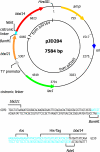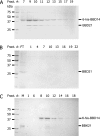Purification and properties of the plasmid maintenance proteins from the Borrelia burgdorferi linear plasmid lp17
- PMID: 18375548
- PMCID: PMC2395045
- DOI: 10.1128/JB.00057-08
Purification and properties of the plasmid maintenance proteins from the Borrelia burgdorferi linear plasmid lp17
Abstract
The Lyme disease spirochete Borrelia burgdorferi carries more plasmids than any other bacterium, many of which are linear with covalently closed hairpin ends. These plasmids have also been referred to as mini-chromosomes and essential genetic elements and are integral components of its segmented genome. We have investigated two plasmid maintenance proteins, BBD14 (the replication initiator) and BBD21 (a presumptive ParA orthologue), encoded by the linear plasmid lp17; these proteins are representatives of paralogous families 62 and 32, respectively. We have purified recombinant 6-his-BBD21 and shown it possesses an ATPase activity. 6-his-BBD14 initially could not be overexpressed in Escherichia coli by itself. It was only effectively overproduced in recombinant form through coexpression with other B. burgdorferi proteins and codon optimization. Although the mechanism for increased production through coexpression is not clear, this method holds promise for expression and purification of other B. burgdorferi proteins, a number of which have remained recalcitrant to purification from E. coli. Finally, we present evidence for the physical interaction of BBD14 and BBD21, a feature suggesting that BBD21 and the paralogous family 32 proteins are more likely involved in DNA replication than functioning as simple ParA orthologues as previously surmised based upon sequence homology. Such a role would not preclude a function in plasmid partitioning through interaction with the replication initiator.
Figures






Similar articles
-
Deletion of a Genetic Region of lp17 Affects Plasmid Copy Number in Borrelia burgdorferi.Front Cell Infect Microbiol. 2022 Apr 12;12:884171. doi: 10.3389/fcimb.2022.884171. eCollection 2022. Front Cell Infect Microbiol. 2022. PMID: 35493747 Free PMC article.
-
Mapping of essential replication functions of the linear plasmid lp17 of B. burgdorferi by targeted deletion walking.Mol Microbiol. 2005 Jul;57(1):132-42. doi: 10.1111/j.1365-2958.2005.04688.x. Mol Microbiol. 2005. PMID: 15948955
-
Topology-dependent transcription in linear and circular plasmids of the segmented genome of Borrelia burgdorferi.Mol Microbiol. 2007 Jan;63(2):443-53. doi: 10.1111/j.1365-2958.2006.05533.x. Mol Microbiol. 2007. PMID: 17241200
-
The plasmids of Borrelia burgdorferi: essential genetic elements of a pathogen.Plasmid. 2005 Jan;53(1):1-13. doi: 10.1016/j.plasmid.2004.10.006. Epub 2004 Dec 16. Plasmid. 2005. PMID: 15631949 Review.
-
The role of genomics in approaching the study of Borrelia DNA replication.J Mol Microbiol Biotechnol. 2000 Oct;2(4):447-54. J Mol Microbiol Biotechnol. 2000. PMID: 11075917 Review.
Cited by
-
Deletion of a Genetic Region of lp17 Affects Plasmid Copy Number in Borrelia burgdorferi.Front Cell Infect Microbiol. 2022 Apr 12;12:884171. doi: 10.3389/fcimb.2022.884171. eCollection 2022. Front Cell Infect Microbiol. 2022. PMID: 35493747 Free PMC article.
-
Transposon mutagenesis as an approach to improved understanding of Borrelia pathogenesis and biology.Front Cell Infect Microbiol. 2014 May 20;4:63. doi: 10.3389/fcimb.2014.00063. eCollection 2014. Front Cell Infect Microbiol. 2014. PMID: 24904839 Free PMC article. Review.
-
Requirements for Borrelia burgdorferi plasmid maintenance.Plasmid. 2012 Jul;68(1):1-12. doi: 10.1016/j.plasmid.2012.01.009. Epub 2012 Jan 24. Plasmid. 2012. PMID: 22289894 Free PMC article.
-
Altered murine tissue colonization by Borrelia burgdorferi following targeted deletion of linear plasmid 17-carried genes.Infect Immun. 2012 May;80(5):1773-82. doi: 10.1128/IAI.05984-11. Epub 2012 Feb 21. Infect Immun. 2012. PMID: 22354033 Free PMC article.
-
Peaceful coexistence amongst Borrelia plasmids: getting by with a little help from their friends?Plasmid. 2013 Sep;70(2):161-7. doi: 10.1016/j.plasmid.2013.05.002. Epub 2013 May 30. Plasmid. 2013. PMID: 23727020 Free PMC article. Review.
References
-
- Bankhead, T., K. Kobryn, and G. Chaconas. 2006. Unexpected twist: harnessing the energy in positive supercoils to control telomere resolution. Mol. Microbiol. 62895-905. - PubMed
-
- Barbour, A. G., and C. F. Garon. 1987. Linear plasmids of the bacterium Borrelia burgdorferi have covalently closed ends. Science 237409-411. - PubMed
-
- Barbour, A. G., and W. R. Zuckert. 1997. Genome sequencing. New tricks of a tick-borne pathogen. Nature 390553, 555. - PubMed
-
- Beaurepaire, C., and G. Chaconas. 2005. Mapping of essential replication functions of the linear plasmid lp17 of B. burgdorferi by targeted deletion walking. Mol. Microbiol. 57132-142. - PubMed
-
- Beaurepaire, C., and G. Chaconas. 2007. Topology-dependent transcription in linear and circular plasmids of the segmented genome of Borrelia burgdorferi. Mol. Microbiol. 63443-453. - PubMed
Publication types
MeSH terms
Substances
LinkOut - more resources
Full Text Sources
Molecular Biology Databases

